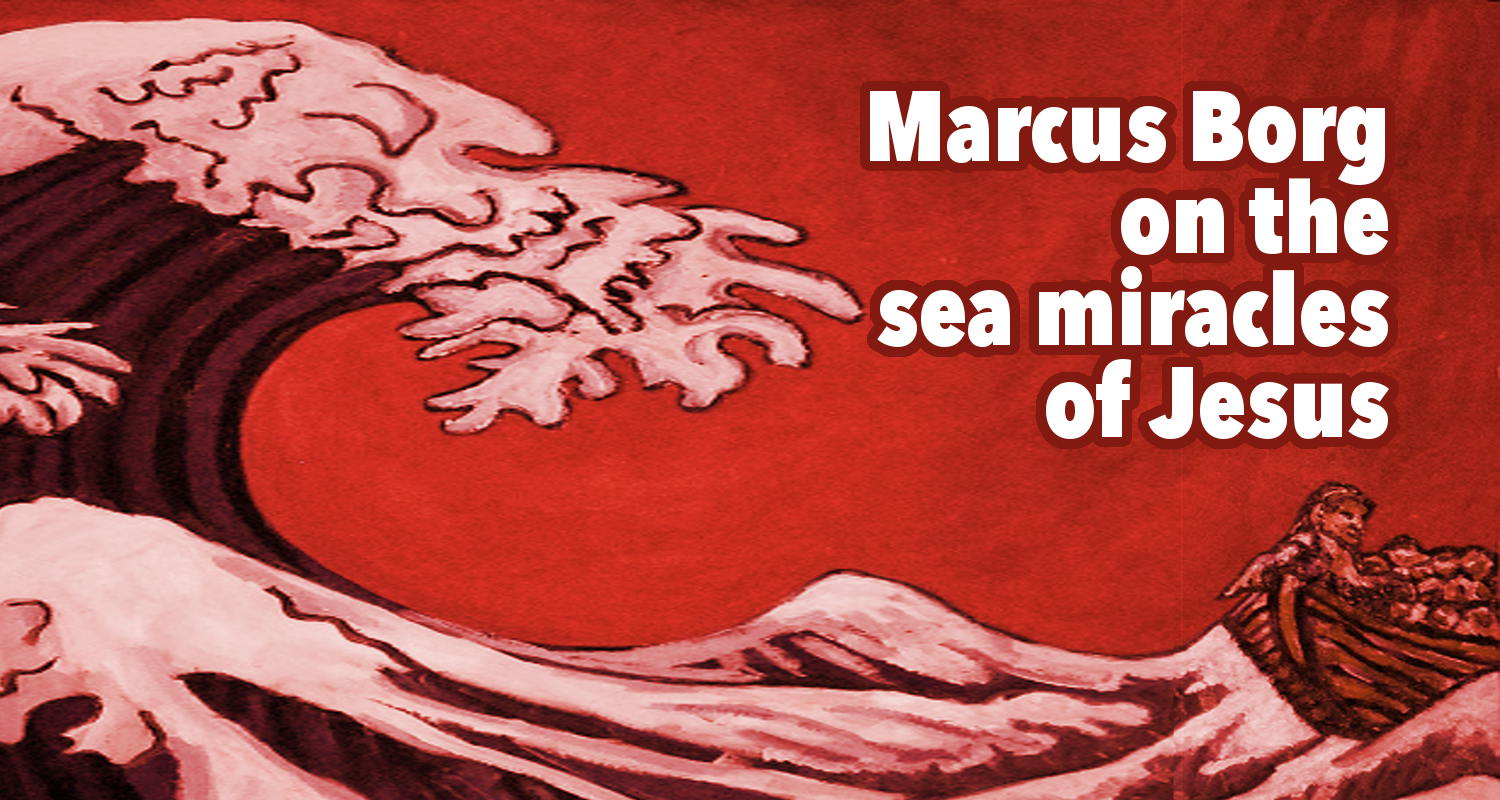 In Jesus: A New Vision (Spirit, Culture, and the Life of Discipleship), Dr. Marcus Borg (1942–2015) provides a briefly and helpful commentary on the stories of Jesus walking on water and stilling the storm in the Gospel of Mark 4:35-41 and 6:45-52. (Variations of these two miracles appear in Mt 8:23–27; Lk 8:22–25 and Matt 14.22-33; John 6:15-21 respectively, and other water miracles throughout the New Testament are relevant, but Borg argues that the Gospel of Mark has historical precedence over these later variations of the same stories.) I generally agree with the scholarly consensus on the priority of the Gospel of Mark, but I believe that the later accounts may also contain historical details that correct and augment the Gospel of Mark.
In Jesus: A New Vision (Spirit, Culture, and the Life of Discipleship), Dr. Marcus Borg (1942–2015) provides a briefly and helpful commentary on the stories of Jesus walking on water and stilling the storm in the Gospel of Mark 4:35-41 and 6:45-52. (Variations of these two miracles appear in Mt 8:23–27; Lk 8:22–25 and Matt 14.22-33; John 6:15-21 respectively, and other water miracles throughout the New Testament are relevant, but Borg argues that the Gospel of Mark has historical precedence over these later variations of the same stories.) I generally agree with the scholarly consensus on the priority of the Gospel of Mark, but I believe that the later accounts may also contain historical details that correct and augment the Gospel of Mark.
The Sea Miracles of Jesus
Revelation 21:1 says that "there will be no more sea." Some of the worst interpretations of the Bible have been based on Revelation, and this verse has been cited to prove that the ocean will not exist after the return of Jesus Christ. On the contrary, the "sea" in the Bible has an apocalyptic meaning that stands for chaos in the world, and Borg does an excellent job explaining that these two miracles of Jesus walking on the water and stilling the storm are stories of overcoming the chaotic sea. The result of both of these miraculous stories is not the annihilation of the Sea of Galilee, but overcoming the storm and placating the tempest / seismic storm (cf. σεισμός in Matt 8:24).
All the water miracles (including the list above) have shared elements about Jesus overcoming the powers of chaos in the sea, so it is likely that the evangelists weaved elements of the Old Testament stories and events in Jesus' life, as these stories were formed in the biblical narratives. There is a biblical precedent in one of my favorites psalms that combines the Exodus story, the Deluge, and elements from Job that Borg quotes:
The stormy wind lifted up the waves of the sea. They mounted up to heaven, they went down to the depths. Their courage melted away in their evil plight; they reeled and staggered like drunken men, and were at their wits' end. Then they cried to the Lord in their trouble, and he delivered them from their distress; he made the storm be still, and the waves of the sea were hushed. (Psalm 107:25-29)
Here is Borg's interpretation of the Markan miracles of Jesus walking on the water and the stilling of the storm:
In both stories [of Jesus stilling the storm and walking on water], they are in a boat, at night, distressed and frightened; in both, Jesus comes to them, the wind cease, and the sea is calmed.
Central to these stories is "the sea," an image which reverberates with rich resonances of meaning in the Hebrew Bible. The Hebrew word for "sea," derived from the name of the evil god in the Babylonian creation story, carried connotations of evil, a mysterious and threatening force opposed to God. Accordingly, when the ancient Hebrews wanted to stress God's power and authority, they spoke of the divine mastery of the sea. The authors of the psalms exclaimed, "The sea is his, for he made it!" and "Thou dost rule the raging of the sea; when its waves rise, thou stillest them." According to the book of Job, it was God who "shut in the sea with doors" and said to it, "Thus far shall you come, and no farther, and here shall your proud waves be stayed."
The plight of the disciples and their cry for help echo another passage from the psalms which describes people in a storm at sea: [Borg quotes Psalm 107:25-29] . . . These connections to language and imagery that were part of the early church's religious-literary tradition suggest that the story is to be understood within that larger framework.
Putting all of these elements together, the narrative makes several points. The picture of Jesus stilling the storm makes the claim that he shares in the power and authority of God; that which was said of God in the Old Testament is now said of Jesus. Moreover, like the Lord of the Psalm narrative, he responds to his followers' cry of distress when the forces of evil and chaos threaten to overwhelm them. Finally, a boat was one of the images for the early church, perhaps by the time Mark's narrative was written. If Mark was making use of this image, then the narrative portrays Jesus as the Lord of the church who saves his people when they turn to him for help in distress. The cry of the disciples is the church's cry, "Save, Lord; we are perishing," and the words of Jesus to the disciples are addressed to the church: "Take heart, it is I, have no fear." In short, the purpose of the narrative may be symbolic rather than historical. Moreover, it is no less true for being symbolic; indeed, its truth is verified int he experience of Christians ever since, quite apart from the historical verdict about whether the story describes an actual incident one night on the Sea of Galilee. [1]
Historicity of the Miracles
Marcus Borg does an excellent job of explaining that an historical narrative is not more true than a symbolic literary (non-historical) narrative. Simply, a presupposition that the miracles of Jesus must be interpreted as historical verifiable events is not the best explanation of the stories as they exist in the Gospel of Mark (and throughout the New Testament). Borg argues that there may be a "historical nucleus" behind the stories, but the history of the historical Jesus has likely been modified and adapted by the early church for kerygmatic purposes.
Borg explains:
"symbolic elements abound in these narratives. The points of correspondence between these stories and the religious-literary tradition of the early church are so frequent and pronounced that perhaps the narratives as whole (and not just details within them) are to be understood primarily or only in terms of how they point beyond themselves rather historically at all. As we have noted, doing so does not require a negative historical judgement; a narrative with symbolic elements can have a historical nucleus. But we will find it most illuminating to consider the stories of these "other powers" as part of the church's story about Jesus, and not primarily as part of the history of Jesus himself." [2]
Borg also argues that Jesus was a "charismatic mediator" that performed might deeds that were consistent with the prophets of the Old Testament. However, the gospels were written before the rise of medicine and science, so it is difficult to say whether the miracles of Jesus align with modern science. For instance, even today it requires a medical expert to declare someone officially dead, and so it is also hard to determine if these stories indicate that Jesus possessed the power of levitation.
Borg explains:
"we simply do not know if there are limits to the powers of a charismatic mediator. For example, are resuscitations of genuinely dead people possible? Or, alternatively, does levitation really happen, and might walking on water be a special case of levitation? That is, the historical verdict about whether or not such events really happened will depend in part upon whether we think even a charismatic can do things like this." [3]
Borg also includes a very helpful footnote on David Friedrich Strauss (who I have discussed from time to time) and how theological scholarship has shifted from a primarily historical interpretation of the miracles of Jesus to a more symbolic interpretation. (As I said early, I tend to favor Barth's interpretation of the gospels in terms of Saga that dialectically mediates between the historical and symbolic interpretations.)
Borg on D. F. Strauss:
The recognition that some miracle stories may be wholly symbolic and not historical is usually credited to David Friedrich Strauss whose two-volume Life of Jesus was published in 1835 when Strauss was only twenty-seven. Prior to Strauss, scholars generally agreed that the miracle stories were to be read as historical narratives, and differed on the question of whether a supernatural or natural explanation of the story was to be sought. . . . Ironically, the explanation preserves the "happenedness" of the story, but destroys the miracle. Strauss cut through this preoccupation with treating the miracle stories as historical and suggested instead that many of the miracle stories are to be understood as literary creation sof the early church which draw upon the rich imagery of the Old Testament: their meaning lies in their symbolism. Strauss' book was radical in his day; a review called it the most pestilent book ever vomited out of the bowels of hell, and he was blackballed from the universities of Europe. With modification, his approach has now become the position of mainstream scholarship. [4]
Conclusion
I have a newfound appreciation for Marcus Borg after reading his excellent and short book Jesus: A New Vision (Spirit, Culture, and the Life of Discipleship), and I'm sharing Borg's interpretation of the miracles of Jesus walking on water and stilling the storm as examples of this great book (that I wish I appreciated more before Borg's death). Overall, I agree with Borg's interpretation, but it does include an element of historical skepticism (especially for the post-Markan water miracles that is unnecessary), so I cannot help but to prefer Karl Barth's interpretation of the calming of the storm. Nevertheless, Borg does an excellent job explaining the non-historical elements of these miracles, and showing that the historical interpretation should not be considered to be truer than symbolic literary narratives.
Sources:
1. Marcus Borg, Jesus: A New Vision (Spirit, Culture, and the Life of Discipleship), Harper Collings (New York: 1991), pp. 68-69
2. Borg. p. 67.
3. Borg. p. 67.
4. Borg. p. 74 [Note #37]
Related: calming of the storm, historical jesus, Jesus, Jesus: A New Vision, Karl Barth, Marcus Borg, Miracle of the Calming of the Storm, sea miracles, Story of the Calming the Storm, walking on water



August 15th, 2020 - 12:28
Excellent, coverage. Very helpful. It is also important to be aware of the multiple audiences implied by the interpretation of these stories. The story teller (s) frame them as events that happened to Jesus and some of his closest followers. The meaning of the events were apparently first available to Jesus’ followers. Thus they form the first audience or the retelling of he stories. Who were these followers in actuality and how might they have interpreted what they first experienced and then heard? Secondly the stories were told and retold to other followers until they became part of the verbal tradition about this man Jesus from Nazareth. Then there was(were) story teller(s) who gathered material that they understood to be central to understanding this man and the meaning or message he embodied. Next appears the cascading number of church communities over the centuries that find identity and meaning in the now ancient stories. And, finally there is me. I my the next in the lineage of interpreters.
November 30th, 2023 - 11:27
Great to read material that makes sense historically. I grew up in a Mennonite religion and the realist’s interpretation of the Bible drove me away from organized religions. At my pastor’s suggestion he lent me several books authored by Borg and/or Crossan. The world needs churches with the foresight to give its members a practical and believable story to bring lost generations to the Kingdom of Love. I am looking forward to sharing these insights to family and friends.
December 3rd, 2023 - 19:54
Thank you for the kind comment. I’m glad this post was helpful for you. I have also been blessed by Borg & Crossan. We need people who ask questions boldly through faith.